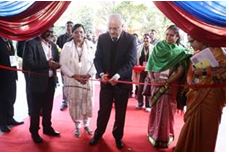



India’s longest rail tunnel, the 14.57-km Janasu Tunnel, is part of the Rishikesh-Karnaprayag rail project in Uttarakhand. Connecting key towns and Char Dham sites, it boosts tourism, economy, and military logistics. With 83% underground track, electrification, and eco-friendly design, it ensures year-round, strategic, and sustainable connectivity.

Copyright infringement not intended
Picture Courtesy: INDIAN EXPRESS
India's longest rail tunnel, the 14.57-km Janasu Tunnel (T-8), is nearing completion on the Rishikesh-Karnaprayag line in Uttarakhand.
The Janasu Tunnel, also called Tunnel No. 8 (T-8), stretches 14.57 kilometers between Devprayag and Janasu in Uttarakhand. It forms a critical part of the 125-km Rishikesh-Karnaprayag Broad Gauge Rail Link Project, an ambitious Indian Railways initiative.
This twin-tube tunnel, designed with one tube already complete and the second expected by July 2025, will be India’s longest rail tunnel, surpassing the 12.77-km T-50 tunnel in Jammu and Kashmir.
The Rishikesh-Karnaprayag line aims to slash travel time from seven hours to just two, connecting five Uttarakhand districts: Dehradun, Tehri Garhwal, Pauri Garhwal, Rudraprayag, and Chamoli.
It will link key towns like Devprayag, Srinagar, Rudraprayag, Gauchar, and Karnaprayag, boosting access to Char Dham pilgrimage sites (Yamunotri, Gangotri, Badrinath, and Kedarnath) and supporting tourism, trade, and local economies.
This rail line, with 83% of its length underground, offers all-weather connectivity, making it a game-changer for Uttarakhand’s hilly regions.
The 125.2-km line includes 16 main tunnels (104 km). The project also features 19 major bridges, five important ones, and 38 minor bridges.

Twelve stations—Yog Nagari Rishikesh, Shivpuri, Byasi, Devprayag, Janasu, Maletha, Ranihat Naithan (Srinagar), Dhari Devi, Tilani, Gholtir, Gauchar, and Karnprayag—will improve regional access.
By connecting pilgrimage sites and remote towns, the line will boost tourism, create jobs (over 2,000 already), and support local businesses. It will also reduce travel costs and open industrial opportunities.
As part of India’s geostrategic push, the line strengthens connectivity to the India-China border, ensuring rapid military deployment.
Indian Railways prioritized sustainability, using electrified tracks and careful construction to protect Uttarakhand’s fragile ecosystem.
Must Read Articles:
Vibrant Village Programme: Improve Border Connectivity
Source:
|
PRACTICE QUESTION Q. With reference to the Vibrant Village Programme, which of the following is NOT a component of the initiative? A) Construction of community toilets and sanitation complexes B) Deployment of armed forces for administrative oversight C) Establishment of solar power plants in remote border hamlets D) Strengthening of anganwadi centers and primary health sub-centers Answer: B Explanation: The Vibrant Village Programme focuses on the socio-economic development of the border villages through infrastructure development, livelihood opportunities, and improved access to basic services. While border security is important in these regions, administrative oversight is handled by civil authorities, not the armed forces. The other options (construction of toilets, establishment of solar power, and strengthening anganwadi centers) are common elements of the programs. |







© 2025 iasgyan. All right reserved